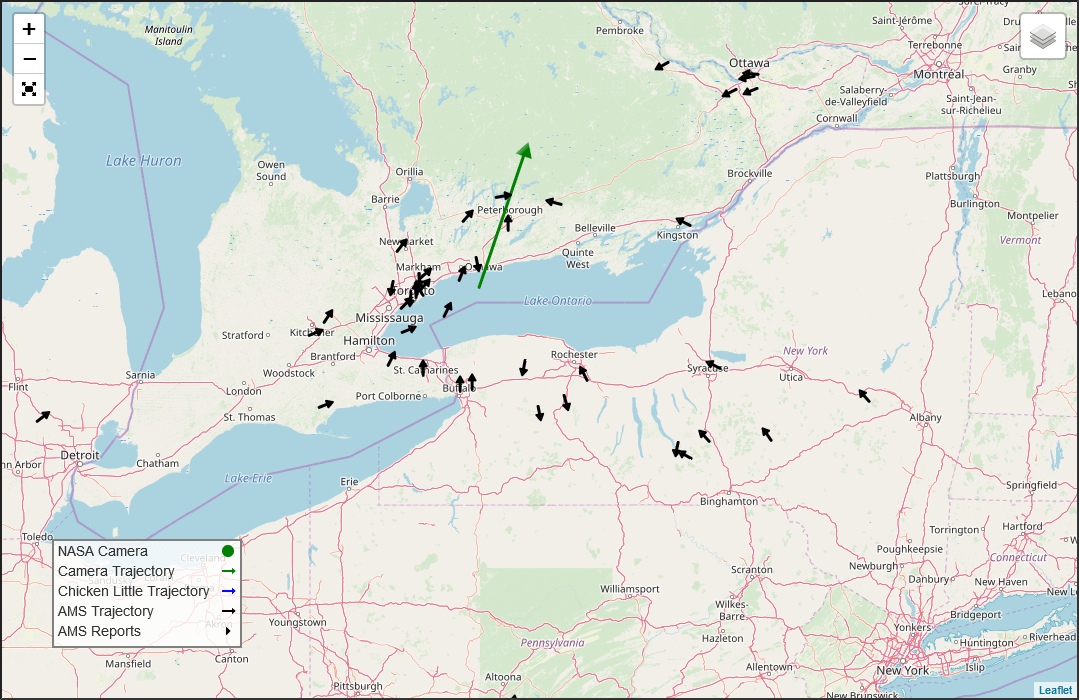On Wednesday, July 24th, the people of the Great Lakes region were treated to a spectacular sight when a meteor streaked across the sky. The resulting fireball was observed by many onlookers, as well as the University of Western Ontario’s All-Sky Camera Network. This array runs across southern Ontario and Quebec and is maintained in collaboration with NASA’s Meteoroid Environment Office (MEO) at the Marshall Space Flight Center.
What is especially exciting about this event is the possibility that fragments of this meteorite fell to Earth and could be retrieved. This was the conclusion reached by Steven Ehlert at the MEO after he analyzed the video of the meteorite erupting like a fireball in the night sky. Examination of these fragments could tell astronomers a great deal about the formation and evolution of the Solar System.
The meteorite was observed by countless people who live in the area surrounding Lake Ontario. This included people as far north as Ottawa and Montreal (in Ontario and Quebec) to as far south as Detroit and Toledo, Michigan. From west to east, residents of Kitchener/Waterloo, Ontario, to Rochester and Syracuse, New York, reported seeing the fireball.
Peter Brown is a professor and the Canada Research Chair of physics and astronomy at UWO who specializes in the study of meteors and comets. Shortly after the event, he confirmed that 10 all-sky cameras of UWO’s Southern Ontario Meteor Network (SOMN) recorded a bright fireball over western Ontario. As Brown explained:
“This fireball likely dropped a small number of meteorites in the Bancroft area, specifically near the small town of Cardiff. We suspect meteorites made it to the ground because the fireball ended very low in the atmosphere just to the west of Bancroft and slowed down significantly. This is a good indicator that material survived.”
According to an analysis of the footage and eye-witness testimony, the fireball first became visible just south of Oshawa, Ontario (over Lake Ontario), at 2:44 A.M. EDT (11:44 A.M. PDT) when the meteorite was at an altitude of 93 km (58 mi). The meteor is believed to have measured roughly 30 cm (12 inches) in diameter before it began to burn and break up.
It then traveled northward over Clarington and west of Peterborough before winking out just west of Bancroft. The fireball it created was as bright as a Full Moon and resulted in a number of bright flares near the end of its flight. These were likely the result of fragments that broke loose and fell to the ground (each of which would be in the gram-sized mass range.
Brown and his colleagues at UWO and the Royal Ontario Museum are currently connecting with people from the area where the fragments could have landed. Hoping to collect them for analysis, he and his colleagues are seeking people may have heard anything unusual on the night in question (which could indicate a piece landing near them) or who may have found any possible fragments.
“Meteorites are of great interest to researchers as studying them helps us to understand the formation and evolution of the solar system,” said Brown. However, this event was of great importance to researchers because there is good-quality footage of the meteorite’s passage through the atmosphere that could provide valuable insight into where the rock came from in our Solar System.
For those who live in the area, Brown and his colleagues have some tips for finding and collecting fragments. Meteorites can be recognized by their dark exterior and often scalloped pattern. They are also likely to be denser than ordinary rocks, and those that have higher metal contents will be detectable using a magnet.
If you come across a meteorite fragment, it is best to put it in a clean plastic bag or wrap it in aluminum foil. They should also be handled as little as possible and stored in a cool, dry place to preserve their scientific value. Also, for residents of Canada, meteorites are the property of the owner of the land where they are found. And remember to first obtain permission of the land-owner before searching on their grounds.
So if you’re in the general area of Bancroft, Ontario, and feel like poking around with a magnet and some sharp eyes, go nuts! What you find could be of immense use to scientists. Just be sure you know who’s property your meteorite-hunting on!
Further Reading: University of Western Ontario

